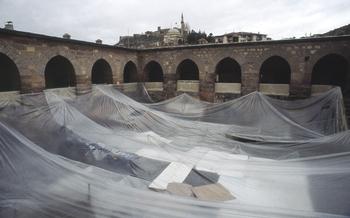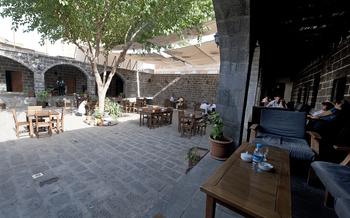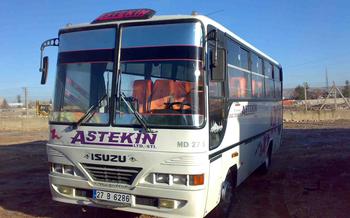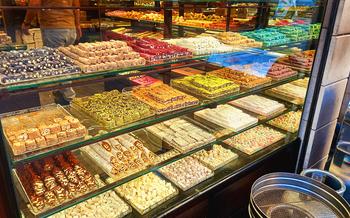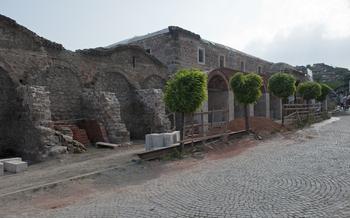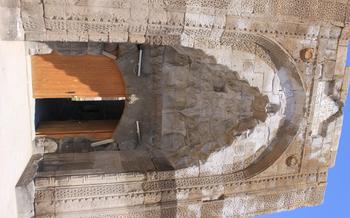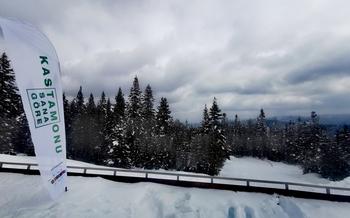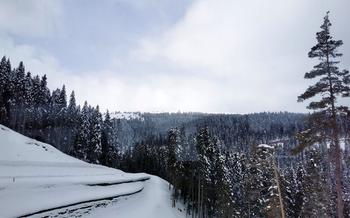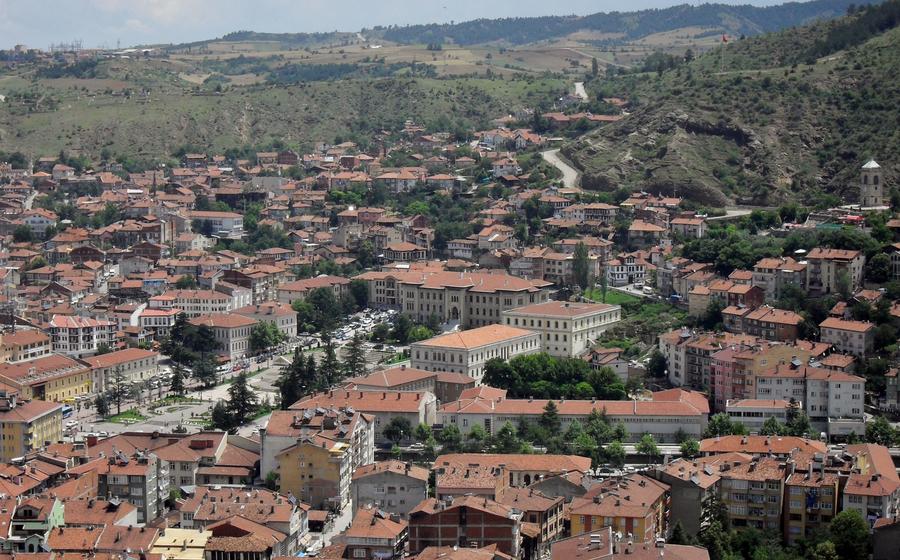
Kastamonu Historic Hans and Caravanserais
- A Journey to Kastamonu's Architectural Heritage
- Kurbanzade Han: A Testament to Architectural Brilliance
- Nasrullah Han
- Köprülü Han: A Historic Caravanserai on the Silk Road
- Taşköprü Han: A Scenic Caravanserai Amidst Nature's Embrace
- Architectural Highlights: A Blend of Form and Function
- Historical Significance: A Vital Link in the Trade Network
- Current Use: Embracing the Past, Enchanting the Present
- Insider Tip: Capturing the Essence of Taşköprü Han
- Gökçam Han: A Hidden Gem of Historic Trade
- Kırca Han: A Restored Gem with a Unique Atmosphere
- Ağaçlı Han: A Haven of Tranquility Amidst History
- Av Köprülü Han
- Haydarzade Han: A Well-Preserved Courtyard Gem
- Hızır Bey Han
- Insider Tip
A Journey to Kastamonu's Architectural Heritage
Turkey, a land steeped in history and cultural diversity, is home to a wealth of architectural treasures that reflect its rich past. Among these are the hans and caravanserais, which played a pivotal role in trade and travel throughout the centuries. In Kastamonu, a charming city in northern Turkey, these historic structures stand as testaments to the city's significant position on the trade routes of the Ottoman Empire.
The hans, with their large courtyards and sturdy construction, provided shelter and accommodation to merchants and travelers. Caravanserais, larger and more elaborate structures, served as resting places for caravans carrying goods along the Silk Road. These architectural marvels are not only important for their historical significance but also for their unique architectural features.
Kastamonu's hans and caravanserais showcase a blend of Ottoman and Seljuk architectural styles, with elements such as stone facades, arched entrances, and intricate carvings. Despite the challenges of time and neglect, many of these structures have been restored and preserved, offering visitors a glimpse into the rich history and architectural heritage of this remarkable city.
Kurbanzade Han: A Testament to Architectural Brilliance
Kurbanzade Han, one of the most prominent hans in Kastamonu, stands as a testament to the city's rich architectural heritage. Constructed in the 17th century, this magnificent structure boasts a captivating blend of Ottoman and Seljuk architectural styles.
The han's striking facade features a grand entrance adorned with intricate stone carvings and elegant arches. The courtyard, a defining feature of Kurbanzade Han, is surrounded by a series of rooms that once accommodated merchants and travelers. These rooms, with their high ceilings and arched windows, offer a glimpse into the bustling atmosphere of the han during its heyday.
The intricately carved wooden doors, a hallmark of Ottoman architecture, add a touch of elegance to the han's overall aesthetic. The courtyard's central fountain, a symbol of purity and tranquility, invites visitors to pause and reflect amidst the vibrant energy of this historic site.
Kurbanzade Han is a living testament to the artistry and craftsmanship of its builders. Today, it serves as a cultural venue, hosting exhibitions, concerts, and other events that celebrate Kastamonu's rich history and vibrant contemporary arts scene.
Nasrullah Han
Nasrullah Han is another remarkable han in Kastamonu that holds significant historical and architectural value. Built in the 15th century during the Ottoman era, this han played a crucial role in facilitating trade and commerce in the region. Its strategic location along the trade routes made it a popular resting point for merchants, travelers, and caravans.
The architectural features of Nasrullah Han are a testament to the skill and artistry of its builders. Constructed from sturdy stone, the han features intricate stonework, graceful arches, and decorative inscriptions. The courtyard, a defining element of traditional hans, forms the central space around which the han is organized. Surrounding the courtyard are guest rooms, stables, and storage areas, all arranged in a harmonious and functional layout.
Presently, Nasrullah Han is undergoing a comprehensive restoration project aimed at preserving its historical integrity and architectural splendor. The restoration efforts involve meticulous repair and conservation work, ensuring that this historic landmark can continue to stand as a symbol of Kastamonu's rich cultural heritage.
Köprülü Han: A Historic Caravanserai on the Silk Road
Traveling along the ancient Silk Road, weary travelers and traders found solace and respite in the historic Köprülü Han. This caravanserai, strategically positioned in Kastamonu, stands as a testament to the region's rich history and its role as a crossroads of cultures.
Köprülü Han's architectural grandeur is evident in its well-preserved courtyard, surrounded by arched alcoves that once served as stables for weary animals. The caravanserai's guest rooms, arranged around the courtyard, provided shelter and comfort to travelers seeking rest and rejuvenation.
Beyond its architectural significance, Köprülü Han holds immense historical value. As a resting point along the Silk Road, it played a crucial role in facilitating trade and cultural exchange between the East and the West. Merchants from distant lands converged here, exchanging goods, ideas, and stories, contributing to the region's vibrant cultural tapestry.
Preserving the historical integrity of Köprülü Han is of utmost importance. Ongoing efforts are underway to maintain its architectural charm and authenticity. By safeguarding this historic caravanserai, we not only preserve a tangible link to the past but also celebrate the enduring spirit of trade, travel, and cultural exchange that has shaped Kastamonu's rich heritage.
Taşköprü Han: A Scenic Caravanserai Amidst Nature's Embrace
Taşköprü Han, also known as Taşköprü Kervansarayı, stands as a testament to the architectural prowess of the past. This well-preserved caravanserai boasts a picturesque setting, nestled amidst nature's tranquility, offering a serene escape for weary travelers.
Architectural Highlights: A Blend of Form and Function
Taşköprü Han's architectural design showcases a harmonious blend of functionality and aesthetics. The caravanserai's courtyard, a central feature, provides a spacious gathering area, while the surrounding arched entrances grant access to individual guest rooms. Each room features vaulted ceilings, adding to the caravanserai's grandeur.
Historical Significance: A Vital Link in the Trade Network
In its heyday, Taşköprü Han played a crucial role in facilitating trade and travel in the region. Situated along a significant trade route, the caravanserai served as a resting point for merchants and travelers traversing the vast Anatolian landscape. Its strategic location made it an essential hub for the exchange of goods and ideas.
Current Use: Embracing the Past, Enchanting the Present
Today, Taşköprü Han has been meticulously restored, retaining its historical charm while adapting to modern-day needs. The caravanserai now welcomes visitors from around the world, offering them a unique opportunity to experience the ambiance of a bygone era. Its serene setting and well-preserved architecture make it a popular destination for history enthusiasts, photographers, and those seeking a tranquil retreat.
Insider Tip: Capturing the Essence of Taşköprü Han
To fully capture the essence of Taşköprü Han, plan your visit during the golden hours of sunrise or sunset. The warm hues of the setting sun cast an enchanting glow on the caravanserai's stone walls, creating a magical atmosphere. For photographers, a wide-angle lens will allow you to capture the caravanserai's grandeur in its entirety.
Gökçam Han: A Hidden Gem of Historic Trade
Gökçam Han stands as a testament to the rich history of Kastamonu's commercial heritage. Nestled amidst the labyrinthine streets of the old city, this han exudes an air of mystery and intrigue. Its architectural features are a blend of traditional Ottoman and local influences, showcasing the city's unique cultural identity. The courtyard, with its intricate stonework and arched entrances, invites visitors to step back in time and imagine the bustling trade that once took place within these walls.
The han's historical significance lies in its role as a center of commerce during the Ottoman era. Merchants from far and wide gathered here to exchange goods, creating a vibrant tapestry of cultures and traditions. The han's strategic location along trade routes made it a crucial hub for the exchange of ideas and commodities.
Despite the passage of time, Gökçam Han retains its charm and authenticity. Its current state reflects the wear and tear of centuries, yet it holds immense potential for restoration or adaptive reuse. With careful conservation efforts, this hidden gem could be transformed into a vibrant cultural center, showcasing Kastamonu's rich heritage and offering visitors a glimpse into the city's commercial past.
Kırca Han: A Restored Gem with a Unique Atmosphere
Kırca Han, a meticulously restored han in Kastamonu, exudes a unique charm that transports visitors back in time. With its meticulously preserved courtyard, adorned with intricate stonework and wooden beams, the han offers a glimpse into the grandeur of its past.
The rooms at Kırca Han are a testament to the han's rich history, featuring arched entrances, decorative elements, and furnishings that evoke a sense of authenticity. Each room tells a story of the travelers who once sought refuge within these walls, creating a tangible connection to the past.
Originally constructed as a center of trade and commerce, Kırca Han played a vital role in facilitating travel and economic activity in the region. Today, it continues to serve as a hub of cultural exchange, having been transformed into a boutique hotel that seamlessly blends history with modern amenities.
Guests at Kırca Han can immerse themselves in the han's unique atmosphere, enjoying a tranquil stay in rooms that have witnessed centuries of history. The hotel's thoughtful restoration efforts have preserved the han's architectural integrity while ensuring that guests have access to all the comforts of modern living.
Whether you're a history enthusiast seeking an authentic experience or simply looking for a serene retreat, Kırca Han offers an unforgettable stay in the heart of Kastamonu's architectural heritage.
Ağaçlı Han: A Haven of Tranquility Amidst History
Ağaçlı Han, nestled amidst the historic tapestry of Kastamonu, stands as a testament to the town's rich past. Its name, translating to "Wooden Han," belies the charm that awaits within its walls.
Built in the 18th century, Ağaçlı Han exudes an aura of serenity with its traditional wooden beams, a testament to the craftsmanship of bygone eras. The courtyard, adorned with a gentle interplay of light and shadow, invites visitors to pause and soak in the ambiance.
As they step inside, travelers are greeted by a series of cozy guest rooms, each imbued with a sense of history. The rooms, with their simple yet elegant furnishings, offer a glimpse into the lives of those who once sought shelter within these walls.
In its heyday, Ağaçlı Han served as a vital stopover for weary travelers and traders traversing the bustling trade routes of Anatolia. The han provided them with a sanctuary, a place to rest and recharge before embarking on the next leg of their journey.
Today, Ağaçlı Han has been lovingly restored, preserving its architectural integrity while adapting to modern needs. It now serves as a popular destination for history enthusiasts, offering a unique blend of heritage and comfort. Visitors can wander through its serene courtyard, marvel at the intricate wooden details, and imagine the stories that these walls could tell.
Whether seeking a tranquil retreat or a glimpse into Kastamonu's rich past, Ağaçlı Han beckons travelers with its timeless allure, inviting them to experience the essence of a bygone era.
Av Köprülü Han
Av Köprülü Han stands as a vital hub along the trade routes of Anatolia. Constructed during the Ottoman era, this caravanserai played a pivotal role in facilitating commerce and providing shelter to weary travelers. Its strategic location made it a popular resting point for caravans transporting goods between the east and the west, contributing to the economic prosperity of the region.
Architecturally, Av Köprülü Han showcases a blend of traditional Ottoman and Seljuk styles. Its spacious courtyard, surrounded by arched entrances, provided a secure haven for both merchants and their animals. The caravanserai featured stables for horses and other pack animals, ensuring their well-being during their long journeys. The arched entrances not only served as decorative elements but also provided practical protection from the elements, creating a sheltered environment for travelers to rest and refresh themselves.
Presently, Av Köprülü Han stands as a reminder of Kastamonu's rich trading past. While its exact condition may require further investigation, the caravanserai's potential for restoration and adaptive reuse is vast. With careful planning and conservation efforts, it could be transformed into a vibrant cultural venue, hosting events, exhibitions, or even serving as a unique accommodation option for visitors seeking an authentic historical experience.
Haydarzade Han: A Well-Preserved Courtyard Gem
Haydarzade Han is another remarkable han in Kastamonu that stands out for its well-preserved courtyard. Constructed during the Ottoman era, this historic building boasts a spacious and serene courtyard that invites visitors to step back in time. The courtyard features intricate stonework, decorative arches, and a central fountain that adds to its charm. The rooms surrounding the courtyard were once used by merchants and travelers seeking shelter and rest during their journeys.
Haydarzade Han's architectural features showcase the craftsmanship and attention to detail that were characteristic of Ottoman architecture. The han's facade is adorned with intricate carvings and inscriptions that hint at its rich history. The courtyard, with its covered walkways and arched entrances, provides a sheltered space for visitors to explore and appreciate the han's architectural beauty.
Currently, Haydarzade Han serves as a cultural venue, hosting exhibitions, workshops, and events that celebrate Kastamonu's history and heritage. Visitors can immerse themselves in the han's ambiance, admire its well-preserved features, and learn about the important role it played in facilitating trade and commerce during the Ottoman era.
Hızır Bey Han
Hızır Bey Han, nestled in the heart of Kastamonu, stands as a testament to the region's rich architectural heritage. Built during the Ottoman era, this han exudes a unique charm and elegance that sets it apart from its counterparts. Its intricate stonework, arched entrances, and decorative elements showcase the artistry and craftsmanship of the period.
Hızır Bey Han boasts a spacious courtyard surrounded by two-story buildings that once served as guest rooms for weary travelers. The rooms feature traditional Turkish architecture, with wooden beams, vaulted ceilings, and ornate details. The courtyard, with its central fountain and lush greenery, provides a tranquil oasis amidst the bustling city.
Throughout history, Hızır Bey Han played a vital role in facilitating trade and travel in the region. It served as a resting point for merchants and caravans traversing the ancient trade routes. The han's strategic location near the city center and its proximity to other historic landmarks made it a popular destination for both locals and visitors alike.
Today, Hızır Bey Han stands as a reminder of Kastamonu's rich past. Although its original purpose as a caravanserai has diminished over time, the han has been meticulously restored and repurposed into a cultural center. It now hosts various exhibitions, workshops, and events that celebrate the city's history and traditions.
As you explore Hızır Bey Han, take a moment to appreciate the intricate details that adorn its walls and arches. Imagine the bustling atmosphere of the past, when merchants from far and wide gathered here to exchange goods and stories. Let the serene ambiance of the courtyard transport you back in time, and experience the timeless charm of this historic gem.
Insider Tip
-
Explore at Your Own Pace: Allocate ample time to explore the hans and caravanserais at your own pace. Allow yourself to soak in the atmosphere, admire the architectural details, and imagine the stories these structures could tell.
-
Capture the Beauty: Bring your camera to capture the stunning beauty of these historic landmarks. Experiment with different angles and lighting conditions to create captivating images that will serve as lasting memories of your visit.
-
Combine History with Culture: Kastamonu offers a wealth of cultural experiences beyond its hans and caravanserais. Visit the Kastamonu Museum to delve deeper into the region's history and culture. Explore the vibrant local markets to discover traditional handicrafts and savor delicious regional cuisine.
